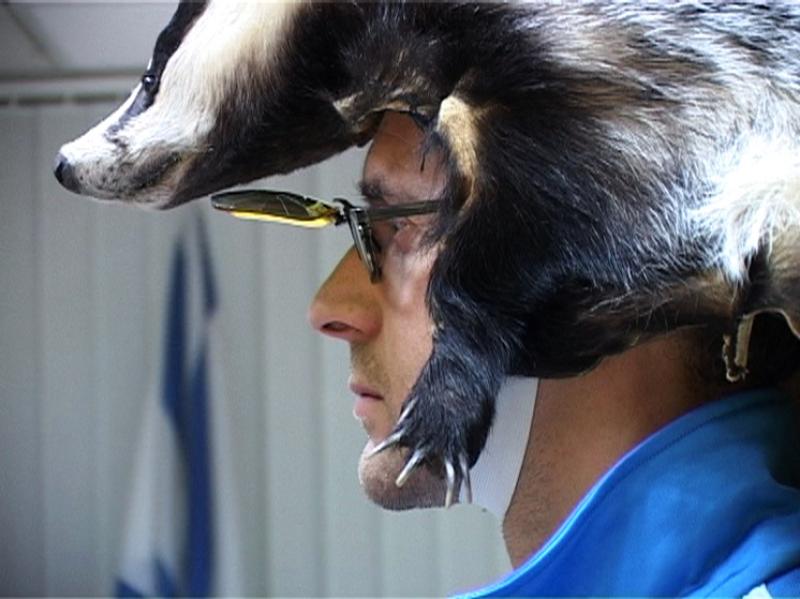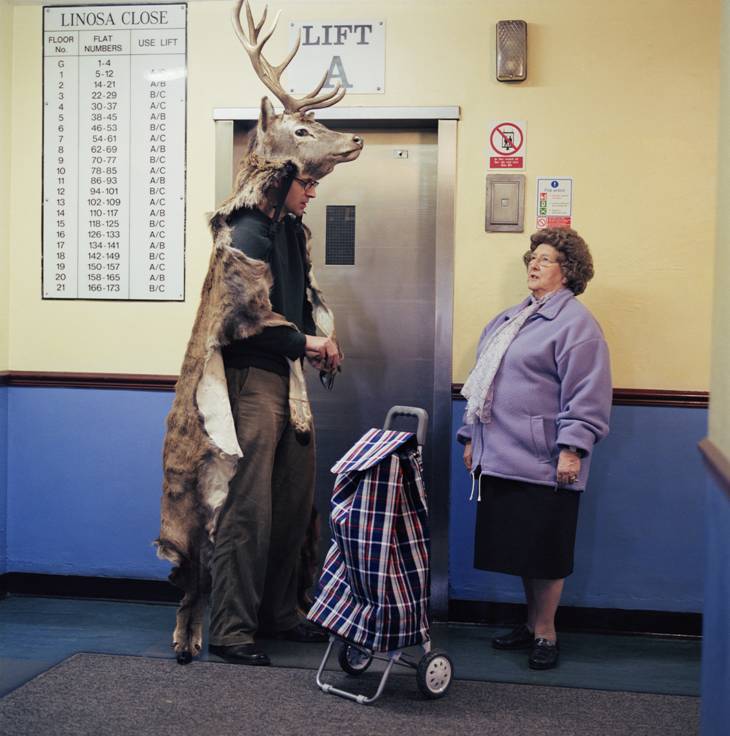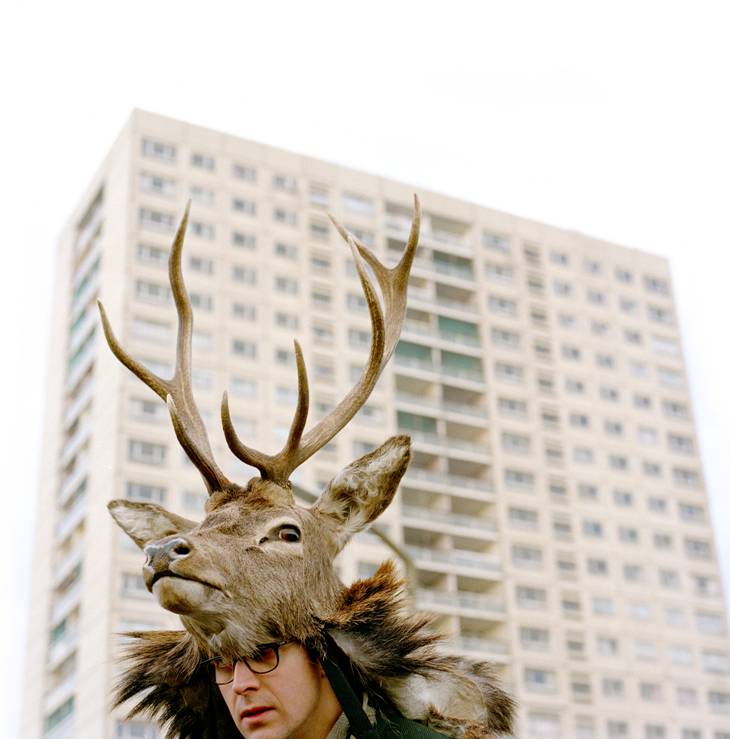10 Questions for Artist Marcus Coates | reviews, news & interviews
10 Questions for Artist Marcus Coates
10 Questions for Artist Marcus Coates
Eccentric visionary talks birds, shamanism, intoxicated animals and the Brighton Festival

Marcus Coates (b. 1968) is an artist who specialises in projects that involve the natural world. Graduating from the Royal Academy School in the early Nineties, by the millennium he was attracting attention for filmed art events that were both eccentric and thought-provoking.
In 2004 the premier of Lower World took place, a shamanistic ritual outside a Liverpool tower block that was about to be demolished, with Coates clad in a deerskin. The latter represented Coates’ ongoing and active interest in shamanism. He was shortlisted in 2013 for his proposal to put a cast of Yorkshire’s tor-like Eagle Rock formation on the Fourth Plinth in Trafalgar Square.
Coates tendency towards the bizarre and comic mask a deeply held desire to explore humankind’s understanding of nature and the world around. He has exhibited in Canada, Finland, Japan, Spain, Switzerland and the US, and brings his Dawn Chorus installation to the Brighton Festival in May.
THOMAS H GREEN: What is the rarest bird you’ve ever seen in the wild?
MARCUS COATES: Probably a flightless cormorant in the Galapagos. There’s only a few of those. I was doing an artists’ residency there, a short programme when the Gulbenkian Foundation sent a few artists out there. I spent three weeks there. It’s amazing to understand the rarity of those species on this island, even this one part of the island, which is very small. It’s the only place these particular creatures exist in the world, so if you step on a lizard you have a huge impact on their global numbers. You really get a sense of your impact as a human.
What is Dawn Chorus?
 It’s a multi-channel video installation so when you walk in you’ll see 14 video screens hanging from the ceiling and on each will be a person singing birdsong. Collectively all these people recreate one morning in a woodland in Northumberland. The dawn chorus itself is what male birds do during springtime in the morning. They sing ferociously to defend their territory and attract mates. That’s the cacophonous sound of the natural phenomenon. My idea was to recreate that very exactly using human voices.
It’s a multi-channel video installation so when you walk in you’ll see 14 video screens hanging from the ceiling and on each will be a person singing birdsong. Collectively all these people recreate one morning in a woodland in Northumberland. The dawn chorus itself is what male birds do during springtime in the morning. They sing ferociously to defend their territory and attract mates. That’s the cacophonous sound of the natural phenomenon. My idea was to recreate that very exactly using human voices.
Dawn Chorus fits in very neatly with the themes that the Festival’s Guest Director, Ali Smith, is putting forward – migrating birds, the meeting of art and the natural world and so on. Did she approach you personally about this?
No, it came through the arts organization Fabrica but they were really keen to tie in with those themes and the timing was really good for them. That crossover of inter-species boundaries has interested me for a long time. Birds are particularly interesting because their lives mirror our own. They build homes, they have very complex ways of communicating vocally, a lot of their culture is similar to ours. Birdsong is a very interesting parallel because even the form of their song - repetition, endurance, musicality - is reflected in how we use music and language in song. We can see so much of ourselves in what birds are doing. They have evolved convergently, even the way they do an alarm call is similar to the way we do an alarm call. I’m using another species to remind us who we are.
I love the concept behind your 2000 art event and film, Out of Season. Tell us about it.
That came from the idea of what are birds doing when they’re singing. We hear a beautiful sound and imagine it a reflection in nature of our best parts. That’s how we use nature. But when you study birdsong there’s a lot of proxy violence. It’s like a battle of the sound systems. The males are pumping out their sound as loudly and in as complex a way as possible to tell all other males they’re the best, the strongest, almost to avoid fighting. The analogy of football supporters is perfect. I got this Chelsea supporter to sing in the forest, all his chants, which are pretty abusive, and they’re all about threatening violence which is what the bird is doing in its battle for survival.
Your work often casts an eye on anthropomorphism – what did you make of Werner Herzog’s film Grizzly Man [a documentary about a man called Timothy Treadwell who devoted his life to living around bears in the wild, with tragic consequences]?
That’s anthropomorphism to an extreme. Anthropomorphism has been given a bad critique because you can see how a projection of human sentiment onto animals does them a disservice. They aren’t a version of us, they’re their own species, autonomous beings, so to call an animal by a name is quite an odd thing. To see their behaviour as part of our own behaviour is not realising the specialities of the animal itself. Then again we’re naturally anthropomorphising creatures. We see faces in anything – clouds, rocks. We want to see the reflection of ourselves in everything. That’s a lot of what we use nature for. We even call the sea, “the cruel sea” or say, “mother earth”. I can totally see why that guy in Grizzly Man saw these bears almost as his friends and projected his love onto them. We expect to have that human relationship with nature. But that’s where we go wrong a lot. We need to negotiate that a bit differently
The guy in Grizzly Man certainly should have. I’ve heard you’re a shaman – where does the shaman fit into 21st Century British society?
Quite a lot of my work is about attempting to become an animal. Dawn Chorus uses digital techniques to let humans sing really accurate birdsong. Traditionally something a shaman would do is literally become animal, non-human, in an attempt to discover information we wouldn’t normally find. Where do we go for our information? The shaman now is mixed into loads of other roles, from judges to actors, police to teachers, but artists inhabits a space where all these roles can be encompassed. Artists are really well trained in the use of imagination, the primary tool of the shaman. I feel I have unique set of skills that could be useful in society. A place for shamanism does exist but it has been diluted.
In 2009 you wore a badger on your head and offered shamanic advice in an Israeli shopping centre. Did anyone try to throw you out?
I was prepared to be thrown out but it always surprises me. I was this stranger from another country dressed in what seemed to other people a ridiculous, comical outfit. For me it was quite intentional, serious and rational. After half an hour there I had a queue of people desperate to ask me questions they couldn’t rationally answer. I was going into a trance, seeing things in my imagination, and telling them what I’d seen. I related that to their questions, coming up with insights.
From reindeers eating psychoactive fungus to elephants boozing on fermented marula fruit, animals are drawn to intoxication. For humans, what do you think of the use of psychedelic drugs to induce trance-like visionary states?
 All animals do that. Interestingly, they’ll get drunk or high if they can. That trance, that altered state of consciousness, that removal of our own everyday consciousness is something we also crave. Does it teach us something, stepping outside ourselves? Probably. Personally I don’t know if the extremeness of using drugs helps me that much. Maybe a cup of tea or a Lucozade, something to get me going. But that is still in touch with the conscious reality within which we communicate. Once we lose touch with that it’s like someone talking about a dream – boring - but if you can have that dream in front of somebody and it’s about them, it starts to have relevance. I like to bring those two worlds together, conscious and unconscious states, to see where they cross over. That’s where shamanism really has a role. Drugs take you too far out so you can’t bring information back.
All animals do that. Interestingly, they’ll get drunk or high if they can. That trance, that altered state of consciousness, that removal of our own everyday consciousness is something we also crave. Does it teach us something, stepping outside ourselves? Probably. Personally I don’t know if the extremeness of using drugs helps me that much. Maybe a cup of tea or a Lucozade, something to get me going. But that is still in touch with the conscious reality within which we communicate. Once we lose touch with that it’s like someone talking about a dream – boring - but if you can have that dream in front of somebody and it’s about them, it starts to have relevance. I like to bring those two worlds together, conscious and unconscious states, to see where they cross over. That’s where shamanism really has a role. Drugs take you too far out so you can’t bring information back.
Which ecological matters are most engaging you right now?
The mass extinction of so many species needlessly because of our wanton destruction of their habitats and the mass increase in our population. The industrialisation of society and the destruction of indigenous societies. The clues to future living for us lie in the traditions of the past. Look at hunter-gathers, how they live and manage relationships with nature. There’s much we can learn but those societies our fast disappearing so it’s not just natural things we’re destroying but our own society as well.
What does Brighton mean to you?
Lots of things, really. I’m excited about showing there. There’s a cultural openness, it’s on the land periphery, on the edge, there’s nowhere further you can go. I lived in San Francisco and I can see a similarity.
Who is Geoff Sample and what does he mean to you?
He’s a renowned wildlife sound recordist. He’s been recording animal vocalisation and natural biospheres for a long time. I came across him 15 years ago when I was listening to birdsong. He became a mythical figure to me then when I lived in Berwick-upon-Tweed for five years I met him for the first time. He was really the key to realising Dawn Chorus as a project because his knowledge of birdsong is amazing
What are you working on at the moment?
I’m doing a project about apes, looking at the similarities between humans, chimpanzees and bonobos. There’s a move to rename these groups of species so that humans, bonobos and chimpanzees are all in the same sub-family. I’ve been coming to the conclusion that there’s not too much difference between a bonobo or a chimpanzee and me and you.
Overleaf: Watch a clip dealing with Dawn Chorus from the BBC4 documentary Why Birds Sing
Explore topics
Share this article
The future of Arts Journalism
You can stop theartsdesk.com closing!
We urgently need financing to survive. Our fundraising drive has thus far raised £49,000 but we need to reach £100,000 or we will be forced to close. Please contribute here: https://gofund.me/c3f6033d
And if you can forward this information to anyone who might assist, we’d be grateful.

Subscribe to theartsdesk.com
Thank you for continuing to read our work on theartsdesk.com. For unlimited access to every article in its entirety, including our archive of more than 15,000 pieces, we're asking for £5 per month or £40 per year. We feel it's a very good deal, and hope you do too.
To take a subscription now simply click here.
And if you're looking for that extra gift for a friend or family member, why not treat them to a theartsdesk.com gift subscription?
more Visual arts
 'We are bowled over!' Thank you for your messages of love and support
Much-appreciated words of commendation from readers and the cultural community
'We are bowled over!' Thank you for your messages of love and support
Much-appreciated words of commendation from readers and the cultural community
![SEX MONEY RACE RELIGION [2016] by Gilbert and George. Installation shot of Gilbert & George 21ST CENTURY PICTURES Hayward Gallery](https://theartsdesk.com/sites/default/files/styles/thumbnail/public/mastimages/Gilbert%20%26%20George_%2021ST%20CENTURY%20PICTURES.%20SEX%20MONEY%20RACE%20RELIGION%20%5B2016%5D.%20Photo_%20Mark%20Blower.%20Courtesy%20of%20the%20Gilbert%20%26%20George%20and%20the%20Hayward%20Gallery._0.jpg?itok=7tVsLyR-) Gilbert & George, 21st Century Pictures, Hayward Gallery review - brash, bright and not so beautiful
The couple's coloured photomontages shout louder than ever, causing sensory overload
Gilbert & George, 21st Century Pictures, Hayward Gallery review - brash, bright and not so beautiful
The couple's coloured photomontages shout louder than ever, causing sensory overload
 Lee Miller, Tate Britain review - an extraordinary career that remains an enigma
Fashion photographer, artist or war reporter; will the real Lee Miller please step forward?
Lee Miller, Tate Britain review - an extraordinary career that remains an enigma
Fashion photographer, artist or war reporter; will the real Lee Miller please step forward?
 Kerry James Marshall: The Histories, Royal Academy review - a triumphant celebration of blackness
Room after room of glorious paintings
Kerry James Marshall: The Histories, Royal Academy review - a triumphant celebration of blackness
Room after room of glorious paintings
 Folkestone Triennial 2025 - landscape, seascape, art lovers' escape
Locally rooted festival brings home many but not all global concerns
Folkestone Triennial 2025 - landscape, seascape, art lovers' escape
Locally rooted festival brings home many but not all global concerns
 Sir Brian Clarke (1953-2025) - a personal tribute
Remembering an artist with a gift for the transcendent
Sir Brian Clarke (1953-2025) - a personal tribute
Remembering an artist with a gift for the transcendent
 Emily Kam Kngwarray, Tate Modern review - glimpses of another world
Pictures that are an affirmation of belonging
Emily Kam Kngwarray, Tate Modern review - glimpses of another world
Pictures that are an affirmation of belonging
 Kiefer / Van Gogh, Royal Academy review - a pairing of opposites
Small scale intensity meets large scale melodrama
Kiefer / Van Gogh, Royal Academy review - a pairing of opposites
Small scale intensity meets large scale melodrama
 Jenny Saville: The Anatomy of Painting, National Portrait Gallery review - a protégé losing her way
A brilliant painter in search of a worthwhile subject
Jenny Saville: The Anatomy of Painting, National Portrait Gallery review - a protégé losing her way
A brilliant painter in search of a worthwhile subject
 Abstract Erotic, Courtauld Gallery review - sculpture that is sensuous, funny and subversive
Testing the boundaries of good taste, and winning
Abstract Erotic, Courtauld Gallery review - sculpture that is sensuous, funny and subversive
Testing the boundaries of good taste, and winning
 Edward Burra, Tate Britain review - watercolour made mainstream
Social satire with a nasty bite
Edward Burra, Tate Britain review - watercolour made mainstream
Social satire with a nasty bite
 Ithell Colquhoun, Tate Britain review - revelations of a weird and wonderful world
Emanations from the unconscious
Ithell Colquhoun, Tate Britain review - revelations of a weird and wonderful world
Emanations from the unconscious

Add comment